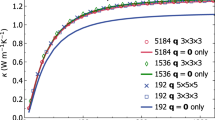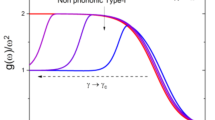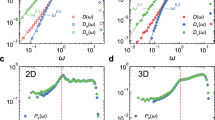Abstract
A microscopic model that provides a satisfactory explanation of the temperature dependence of the thermal conductivity coefficient for dielectric glasses in the temperature range above the plateau is proposed for the first time. According to this model, the transfer of thermal perturbations occurs through harmonic interaction of oscillators localized at medium-range order clusters with hinged bonds. It is demonstrated that the interaction coefficient of these clusters depends on the overlap integral of the spectral lines attributed to natural vibrations of the clusters, whereas the temperature behavior of the thermal conductivity coefficient is governed by the temperature evolution of the widths of the vibrational lines. With due regard for the results of investigations into the broadening of the vibrational lines, the temperature dependence of the thermal conductivity coefficient is calculated in the range 10–500 K. The calculated curve is in good agreement with the experimental data. The proposed model accounts for the low thermal conductivity of glasses in the temperature range under consideration.
Similar content being viewed by others
REFERENCES
Zeller, R.C. and Pohl, R.O., Thermal Conductivity and Specific Heat of Noncrystalline Solids, Phys. Rev. B: Solid State, 1971, vol. 4, no. 6, pp. 2029–2040.
Trakhtenberg, L.I. and Flerov, V.N., Thermodynamic and Kinetic Properties of Amorphous Dielectrics at Low Temperatures, Zh. Eksp. Teor. Fiz., 1982, vol. 83, no. 6, pp. 1908–1923.
Karpov, V.G. and Parshin, D.A., On the Thermal Conductivity of Glasses at Temperatures below the Debye Temperature, Zh. Eksp. Teor. Fiz., 1985, vol. 88, no. 6, pp. 2212–2227.
Ramos, M.A. and Buchenau, U., Low-Temperature Thermal Conductivity of Glasses within the Soft-Potential Model, Phys. Rev. B: Condens. Matter, 1997, vol. 55, no. 9, pp. 5749–5754.
Jones, D.P. and Phillips, W.A., Thermal Conductivity of Vitreous Silica, Phys. Rev. B: Condens. Matter, 1983, vol. 27, no. 6, pp. 3891–3894.
Jones, D.P., Jäckle, J., and Phillips, W.A., Dispersion and Thermal Conductivity of SiO2, in Phonon Scattering in Condensed Matter, Maris, H.J., Ed., New York: Plenum, 1980.
Anderson, A.C., Schroeder, J., and McDonald, W.M., Low-Temperature of Potassium and Sodium Silicate Glasses, Phys. Rev. B: Condens. Matter, 1985, vol. 31, no. 2, pp. 1090–1101.
Jäckle, J., On Phonon Localization in Nearly Dimensional Solids, Solid State Commun., 1981, vol. 39, no. 11, pp. 1261–1263.
Dixon, G.S., Galt, B.D., Shu-Yun Shi, Watson P.A., and Wickted J.P., Thermal Transport in Silicate Glasses: I. Localized Phonons, Phys. Rev. B: Condens. Matter, 1994, vol. 49, no. 1, pp. 257–264.
Alexander, S., Entin-Wohlman, O., and Orbach, R., Phonon-Fracton Anharmonic Interaction: The Thermal Conductivity of Amorphous Materials, Phys. Rev. B: Condens. Matter, 1986, vol. 34, no. 4, pp. 2726–2734.
Cahill, D.G. and Pohl, R.O., Thermal Conductivity of Amorphous Solids above the Plateau, Phys. Rev. B: Condens. Matter, 1986, vol. 35, no. 8, pp. 4067–4073.
Cahill, D.G. and Pohl, R.O., Heat Flow and Lattice Vibrations in Glasses, Solid State Commun., 1989, vol. 70, no. 10, pp. 927–930.
Denisov, Yu.V. and Zubovich, A.A., Density of Vibrational States of a Glass on the Medium-Range Order Scale, Fiz. Khim. Stekla, 1999, vol. 25, no. 4, pp. 423–433 [Glass Phys. Chem. (Engl. transl.), 1999, vol. 25, no. 4. pp. 320–327].
Jäckle, J., Low-Frequency Raman Scattering in Glasses, in Amorphous Solids: Low Temperature Properties, Phillips, W.A., Ed., Berlin: Springer, 1981.
Denisov, Yu.V. and Rylev, A.P., Structural Relaxations and Light Scattering in Nitrate Glasses, Fiz. Khim. Stekla, 1999, vol. 25, no. 4, pp. 402–415 [Glass Phys. Chem. (Engl. transl.), 1999, vol. 25, no. 4. pp. 304–313].
Clare, C.Yu. and Freeman, J.J., Thermal Conductivity and Specific Heat of Glasses, Phys. Rev. B: Condens. Matter, 1987, vol. 36, no. 14, pp. 7620–7624.
Stephens, R.B., Intrinsic Low-Temperature Thermal Properties of Glasses, Phys. Rev. B: Solid State, 1976, vol. 13, no. 2, pp. 852–865.
Author information
Authors and Affiliations
Rights and permissions
About this article
Cite this article
Denisov, Y.V., Zubovich, A.A. The Role of Vibrations of Medium-Range Order Clusters in Thermal Conduction of Materials with a Disordered Structure. Glass Physics and Chemistry 29, 237–242 (2003). https://doi.org/10.1023/A:1024477914328
Issue Date:
DOI: https://doi.org/10.1023/A:1024477914328




